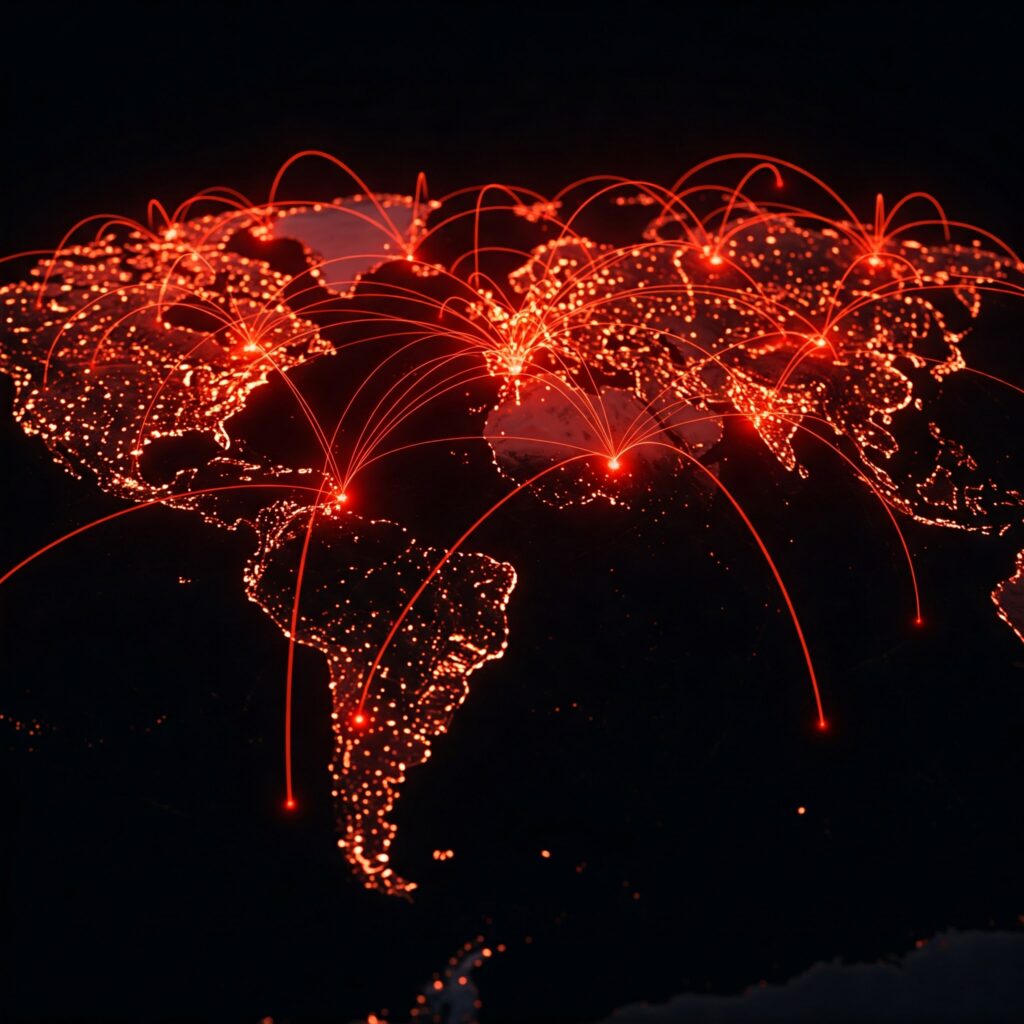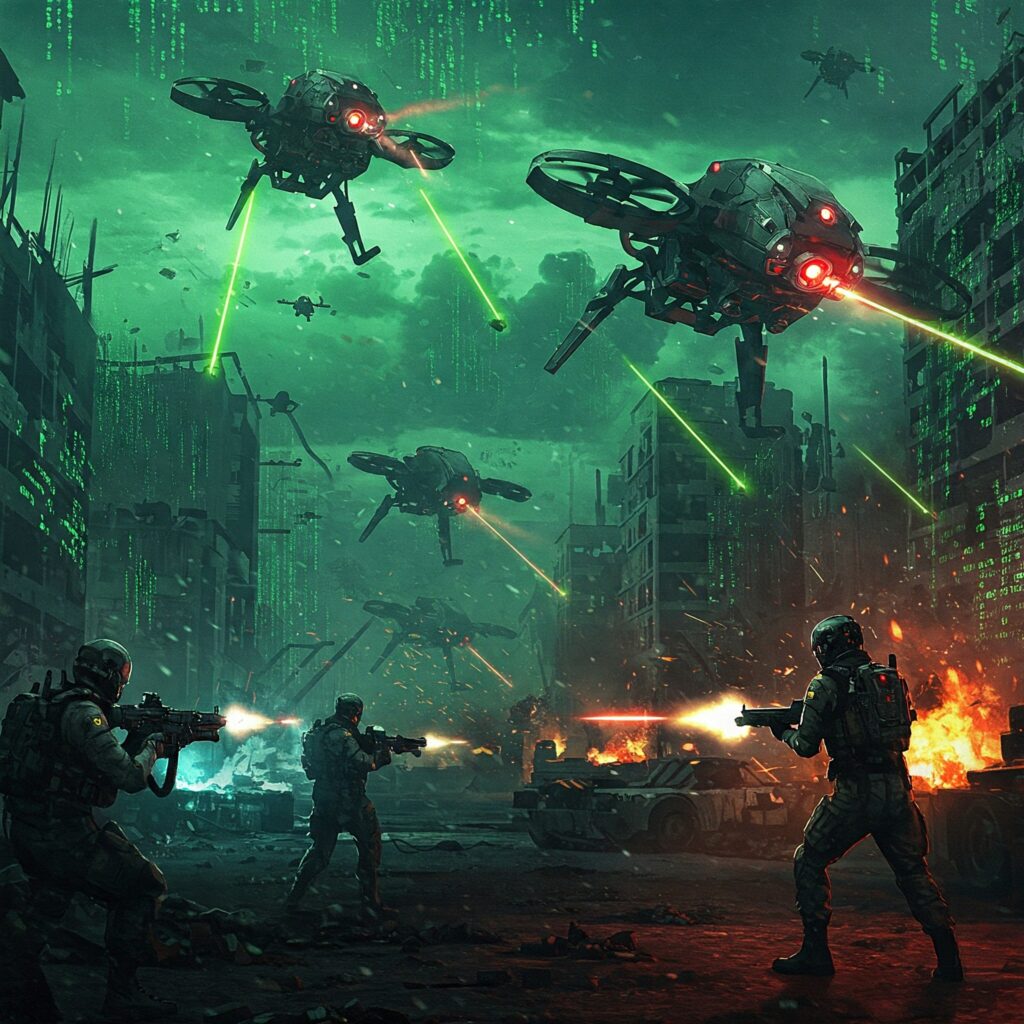
💣 War has gone digital.
In 2025, AI-powered cyberwarfare is the most powerful weapon on the planet—faster than missiles, more precise than spies, and unstoppable once unleashed. Nations no longer need armies to dominate—they just need AI. AI-powered cyberwarfare has emerged as the weapon of choice for nations seeking to assert dominance, gather intelligence, or destabilize rivals without firing a single physical shot. This silent war, waged through keyboards and algorithms rather than bullets and bombs, presents unprecedented challenges to national security threats, economic stability, and even democratic processes worldwide.
Unlike conventional cyber operations of the past decade, today’s AI-powered cyberwarfare threats operate autonomously, adaptively, and at speeds that would have been unimaginable just a few years ago. Where traditional state-sponsored cyber attacks once required teams of skilled human hackers working around the clock, AI has democratized and supercharged digital warfare, enabling even smaller nations to punch far above their weight class in the global arena of national security threats.
This comprehensive analysis explores how nations are leveraging artificial intelligence to revolutionize AI-powered cyberwarfare in 2025, the far-reaching implications for global national security, and the defensive strategies emerging in response to these evolving threats.
🤖 The Rise of AI-Powered Cyberwarfare
The fusion of artificial intelligence with offensive cyber capabilities has fundamentally altered the nature of digital conflict. Today’s AI-powered cyberwarfare attacks are defined by several key characteristics that make them particularly dangerous:
✔ Self-learning systems that evolve based on real-time security responses, continuously adapting to overcome defensive measures
✔ Autonomous operation enabling state-sponsored cyber attacks to launch, spread, and adapt without human intervention
✔ Unprecedented scale allowing simultaneous targeting of thousands of critical infrastructure protection systems across multiple sectors
✔ Deceptive capabilities leveraging deepfake technology and AI-driven social engineering to manipulate targets
According to the Center for Strategic and International Studies (CSIS), major state-sponsored cyber attacks have increased dramatically, with AI involvement doubling since 2023. This surge reflects the global arms race in cyberspace, where artificial intelligence has become the decisive competitive edge in national security threats.
The consequences of this AI revolution in AI-powered cyberwarfare extend far beyond data breaches or service interruptions. Power grids can now be shut down without warning, threatening critical infrastructure protection, deepfake technology can manipulate global elections with frightening authenticity, and AI-driven espionage can compromise national security in ways previously confined to science fiction.
Related: Learn about how AI-assisted hacking is changing cybersecurity and what you can do to stay protected.
💣 How Nations Are Weaponizing AI for Cyberwarfare
In the shadowy realm of offensive cyber operations, nations are developing and deploying increasingly sophisticated AI tools to achieve strategic objectives:
💻 Launch automated state-sponsored cyber attacks against enemy infrastructure
🛡 Conduct AI-driven espionage to steal classified intelligence
🎭 Create deepfake disinformation campaigns to manipulate elections
🔍 Perform autonomous reconnaissance to identify critical vulnerabilities
⚡ Develop self-adapting malware that evades traditional AI cyber defense measures
Affiliate Disclosure: This post contains affiliate links. If you purchase through these links, we may earn a small commission at no extra cost to you. We only recommend products we trust and use ourselves. Learn more about our affiliate policy.
1. 🚀 How AI Is Transforming Offensive Cyber Operations
📈 The Evolution of AI-Powered Cyber Tactics
In 2025, artificial intelligence is no longer merely assisting cyber operations—it’s driving them. Autonomous AI-powered cyberwarfare operations allow nations to attack foreign critical infrastructure protection systems, disrupt financial markets, and extract classified intelligence with minimal human oversight. This shift represents a fundamental change in how nations approach digital warfare, moving from human-directed operations to machine-led campaigns that operate at machine speed, creating unprecedented national security threats.
🔗 How AI is Being Used in Cyberattacks (And How to Defend Yourself)
🔥 Key AI Cyberwarfare Tactics Used in 2025
🚀 AI-powered malware – Unlike traditional malware with fixed code, AI-driven malware rewrites itself in real time, evades detection, self-replicates, and strategically targets critical infrastructure.
🚀 AI-enhanced zero-day exploits – AI autonomously identifies and exploits unknown vulnerabilities in government and corporate systems, often breaching networks before patches exist.
🚀 Deepfake-based deception – AI-generated videos, audio, and messages spread disinformation, manipulate elections, and influence military decisions, escalating national security risks.
🚀 Automated reconnaissance and penetration testing – AI scans billions of digital endpoints in minutes, identifying weak spots in enemy systems with unmatched speed and accuracy.
🚀 Resource optimization attacks – AI orchestrates multi-target cyberattacks, hitting power grids, financial networks, and defense systems simultaneously with minimal human oversight.
💥 Example: In 2024, North Korean state-sponsored cyber attacks deployed an AI-driven phishing campaign that cloned government officials’ voices in real-time conversations, successfully tricking senior diplomats into sharing confidential NATO intelligence. This attack, which would have been impossible without advanced AI voice synthesis, demonstrated how artificial intelligence is elevating traditional cyber tactics to new levels of sophistication and creating severe national security threats.
2. 🌐 AI-Powered Cyberwarfare Superpowers: The Global Landscape
⚔️ The AI Cyberwarfare Arms Race
In 2025, nations across the globe are competing intensely to develop and deploy the most advanced AI-powered cyberwarfare capabilities. While the United States, China, and Russia remain at the forefront of this technological arms race, other nations are rapidly closing the gap, creating a more complex and dangerous digital battlefield for national security threats.
🏆 Which Countries Are Leading AI-Driven Cyberwarfare?
🌎 United States:
- 🛡️ Develops AI cyber defense tools to counter foreign cyber threats
- ⚔️ Uses offensive AI-powered cyberwarfare capabilities for preemptive cyber strikes against state-sponsored hacking groups
- 🔒 Invests heavily in quantum encryption to protect against AI-driven decryption attacks
- 💰 Has allocated approximately $15 billion in 2025 to counter national security threats through the Pentagon’s AI cyber defense program
🐉 China:
- 💼 Specializes in AI-powered cyberwarfare intellectual property theft, targeting Western defense, biotech, and semiconductor industries
- 🕵️ Uses sophisticated AI cyber espionage tools to infiltrate government agencies and corporations
- 📡 Deploys AI-powered surveillance networks to monitor and suppress dissidents
- 💣 Believed to be behind the 2024 breach of a U.S. telecom providers using state-sponsored cyber attacks
🐻 Russia:
- 🎭 Leads in AI-powered cyberwarfare psychological operations and deepfake propaganda
- 🗳️ Uses AI-driven disinformation campaigns to manipulate global elections and public sentiment
- 🤖 Deploys autonomous cyber botnets that spread AI-generated fake news across social media platforms
- ⚡ Used state-sponsored cyber attacks to disrupt Ukrainian critical infrastructure protection systems in late 2024, affecting over 200,000 homes
🌐 Emerging Cyber Powers:
- Iran has developed sophisticated AI tools for targeting critical infrastructure protection systems in the Middle East
- North Korea leverages AI-powered cyberwarfare to enhance its cryptocurrency theft operations, funding its military programs
- Israel employs advanced AI cyber defense for defensive capabilities and targeted cyber intelligence operations
- 🌍 Smaller nations are increasingly acquiring off-the-shelf AI tools from dark web markets to conduct their own state-sponsored cyber attacks
💥 Example: In March 2024, the U.S. and U.K. filed charges and imposed sanctions on individuals and a front company linked to APT31, a Chinese state-backed hacking group accused of conducting a global cyber-espionage campaign for over a decade. The group, allegedly operating under China’s Ministry of State Security, targeted millions of individuals, including government officials, lawmakers, activists, and defense contractors, using malicious phishing campaigns to steal intelligence, influence geopolitical events, and compromise critical institutions before security agencies publicly identified their activities.
🔒 Protect Yourself from AI-Powered Cyber Threats! Use a secure VPN like NordVPN, Proton VPN or Surfshark to encrypt your data and stay anonymous while browsing.
3. ⚙️ The Mechanics of AI in Offensive Cyber Operations
🦠 AI-Powered Malware: The Heart of Modern Cyberwarfare

AI-powered cyberwarfare malware represents the most significant advancement in offensive cyber capabilities since the development of Stuxnet. Unlike traditional malware with predictable behaviors, AI variants demonstrate remarkable adaptability:
- 🧬 Self-modification – These systems analyze their own code and make modifications to avoid detection patterns
- 🧠 Behavioral learning – They study the environment they infiltrate and adjust tactics accordingly
- 🎯 Target prioritization – AI malware can identify and focus on the most valuable assets in a network
- 🤖 Autonomous decision-making – These systems can determine when to activate, spread, or remain dormant
💥 The Most Advanced AI Cyberwarfare Strategies
🔴 Self-learning AI malware – Uses machine learning to evade detection, adapting instantly to security patches and signatures, sometimes within minutes of updates.
🔴 AI-generated phishing attacks – AI-crafted spear-phishing emails are nearly indistinguishable from real government or corporate messages, leveraging contextual awareness that traditional phishing lacked.
🔴 AI-enhanced cyber sabotage – AI bots infiltrate critical infrastructure, learning operational patterns to manipulate power grids, water systems, and nuclear plants, maximizing disruption and damage.
🔴 Targeted sector attacks – State-sponsored cyberattacks focus on high-value sectors like healthcare, transportation, and finance, strategically exploiting national vulnerabilities.
💥 Example: In 2024, Russian cyber units deployed AI-powered cyberwarfare deepfake technology to fabricate a diplomatic incident between NATO allies, creating synthetic video evidence of a high-ranking official making inflammatory statements. The fabrication was so convincing that it sparked genuine diplomatic tensions before intelligence agencies could confirm the deception, highlighting the need for advanced AI cyber defense capabilities.
🛡️ The Future of AI-Powered Cyberwarfare & Global Defense Strategies
🔒 How Governments Are Responding to AI Cyberwarfare
As AI-powered cyberwarfare evolves into the primary battlefield of international conflict, governments and military organizations worldwide are implementing increasingly sophisticated defensive measures:
🛡️ AI-driven predictive threat intelligence – AI-powered cyber defense systems analyze attack patterns, network anomalies, and hacker behaviors to predict and neutralize threats before they are fully executed.
🛡️ Autonomous cybersecurity networks – AI defense tools detect and counter AI-driven cyberattacks in real time, operating at machine speed without human intervention.
🛡️ Quantum cryptography – Nations are racing to develop quantum-resistant encryption to protect national security data from AI-powered decryption threats.
🛡️ International cooperation – Cyber defense alliances are expanding, emphasizing intelligence sharing and joint security efforts to combat state-sponsored cyberattacks.
🛡️ Regulatory frameworks – The EU’s Cyber Resilience Act mandates AI-ready security for critical infrastructure, with similar policies emerging worldwide.
⏱️ Cybersecurity 2025: A Race Against Time
Defending against AI-powered cyberwarfare in 2025 is becoming increasingly challenging. Traditional antivirus software, signature-based detection, and manual monitoring are proving inadequate against the speed and adaptability of AI-powered threats. Both governments and private organizations face several critical national security threats:
- 💹 Economic vulnerabilities – A single sophisticated state-sponsored cyber attack could potentially crash stock markets or halt international trade
- 🏥 Public safety concerns – Attacks on hospitals, transportation systems, or utility infrastructure could directly threaten human lives, highlighting the importance of critical infrastructure protection
- 🔐 National security implications – Stolen military intelligence or compromised defense systems could dramatically shift global power balances
The World Economic Forum (WEF) has warned in its January 2025 report that unchecked AI-powered cyberwarfare could cost the global economy an estimated $20 trillion by 2030. This staggering figure underscores the urgent need for more robust AI cyber defense capabilities and international norms governing the use of AI in cyber operations.
🛡️ Protect Your Business from AI-Driven Attacks! Upgrade to an AI-powered firewall like Firewalla Gold or safeguard sensitive data with ProtonMail’s encrypted email service.
🌍 The Broader Implications of AI-Powered Cyberwarfare
The rise of AI-powered cyberwarfare extends far beyond immediate technical concerns, touching fundamental aspects of international relations and societal trust:
- 💔 Erosion of digital trust – Citizens increasingly question the reliability of digital systems, from banking to voting infrastructure
- 🧩 Blurred lines of attribution – AI-enabled state-sponsored cyber attacks make definitively identifying the responsible parties increasingly difficult
- 🧨 Escalation risks – Cyber conflicts could potentially trigger conventional military responses if attribution is clear
- ⚖️ Digital inequality – Nations with advanced AI capabilities gain significant advantages over less technologically developed countries
- 👁️ Privacy concerns – The AI cyber defense measures needed to counter AI threats may require more invasive monitoring of networks
In 2025, the line between cyber and physical warfare continues to blur, creating new challenges for international law, military doctrine, and civil liberties. This evolving landscape requires a balanced approach that protects national security without sacrificing the openness and innovation that defines the digital age.
🔒 Protecting Against AI-Powered Cyber Threats
📱 Keep Your Devices Safe from AI Espionage! Block remote tracking with a Faraday bag or use Guardio to protect against malicious phishing attacks.
🛡️ National Defense Strategies
Nations are developing multi-layered approaches to counter AI-powered cyberwarfare threats:
- 🤖 AI vs. AI – Deploying AI cyber defense systems that can match the speed and adaptability of offensive tools
- 🏢 Critical infrastructure hardening – Implementing air-gapped networks and redundant systems for essential critical infrastructure protection
- 👩💻 Workforce development – Training new generations of cybersecurity professionals with AI expertise to combat national security threats
- 🤝 Public-private partnerships – Collaborating with technology companies to identify and address vulnerabilities
- ⚠️ Deterrence through attribution – Developing better capabilities to identify sources of state-sponsored cyber attacks despite AI obfuscation
🏛️ Organizational Cybersecurity Measures
For businesses and organizations, protecting against AI-powered cyberwarfare threats requires a fundamental rethinking of security approaches:
- 🚫 Zero-trust architecture – Assuming systems are already compromised and requiring continuous verification
- 🔍 AI-driven security monitoring – Implementing machine learning tools that can detect subtle anomalies in network behavior
- 🧪 Regular penetration testing – Using ethical hackers to identify vulnerabilities before they can be exploited by state-sponsored cyber attacks
- ⛓️ Supply chain security – Rigorously vetting all software and hardware vendors for potential vulnerabilities
- 👨🏫 Employee training – Educating staff about AI-generated phishing and social engineering tactics used in modern AI-powered cyberwarfare
Related: Top 5 Breakthrough AI-Powered Cybersecurity Tools Protecting Businesses in 2025

👤 Personal Protection Measures
While nation-states battle in cyberspace, individuals aren’t helpless against the spillover effects of AI-powered cyberwarfare:
- 🔒 Use robust VPN services to encrypt internet traffic and protect against surveillance
- 🔑 Implement multi-factor authentication on all sensitive accounts
- 🔄 Regularly update software to patch known vulnerabilities that could be exploited by state-sponsored cyber attacks
- 🧐 Be skeptical of unsolicited communications, particularly those requesting sensitive information
- 💬 Use encrypted messaging platforms for sensitive communications
- 📱 Consider physical security measures like Faraday bags for critical devices when not in use
Related: Best AI-Powered VPNs for Privacy in 2025
⚖️ The Ethical Dimension of AI Cyberwarfare
As AI-powered cyberwarfare capabilities advance, profound ethical questions emerge about their development and use:
- ⚖️ Proportionality – What constitutes a proportional response to an AI-driven cyberattack?
- 👨👩👧👦 Civilian impact – How can nations minimize collateral damage to civilian infrastructure during state-sponsored cyber attacks?
- 🤔 Autonomous decision-making – Should AI systems be permitted to make offensive strike decisions without human approval?
- 📜 International norms – What rules should govern the use of AI in cyber operations and critical infrastructure protection?
- ⚠️ Accountability – Who is responsible when AI cyber defense systems cause unintended harm?
These questions lack easy answers but will shape the future of international security and the digital landscape for decades to come.
🔮 Preparing for the Future of AI Cyberwarfare

Looking beyond 2025, several trends appear likely to define the next evolution of AI-powered cyberwarfare:
- 🤖 Fully autonomous cyber operations that can plan and execute complex attacks without human guidance, creating unprecedented national security threats
- ⚛️ Integration of quantum computing with AI to create even more powerful offensive capabilities to defeat traditional AI cyber defense systems
- 🧠 Neuromorphic computing systems that more closely mimic human cognitive processes while operating at machine speeds
- 🧬 Biological-digital interface attacks targeting increasingly connected medical and neural devices
- 🛰️ Space-based cyber operations affecting satellite networks and space infrastructure critical to critical infrastructure protection
Preparing for these emerging threats will require unprecedented cooperation between nations, industries, and technical experts, along with a willingness to establish binding international norms around AI use in conflict.
🔥 Stay ahead of AI cyberwarfare. Sign up for our cybersecurity newsletter and updates here →
📝 Key Takeaways
- 🔥 AI-powered cyberwarfare has fundamentally transformed the nature of global conflict in 2025, enabling attacks that are faster, more adaptive, and more devastating than traditional cyber operations
- 🌐 State-sponsored cyber attacks enhanced by AI pose significant threats to critical infrastructure protection, financial systems, and democratic processes worldwide
- 🏆 The United States, China, and Russia lead in developing AI-powered cyberwarfare capabilities, but smaller nations are rapidly acquiring similar tools
- 🚀 Key AI cyberwarfare tactics include self-modifying malware, deepfake deception, and autonomous system infiltration that challenge existing AI cyber defense systems
- 🛡️ Defending against AI-powered cyberwarfare requires equally sophisticated AI cyber defense systems, international cooperation, and regulatory frameworks
- 💰 The economic impact of unchecked AI-powered cyberwarfare could reach $20 trillion by 2030 according to the World Economic Forum
- 🔮 Future developments in quantum computing and neuromorphic systems will likely further accelerate the AI cyber arms race, creating new national security threats
❓ FAQ: AI-Powered Cyberwarfare in 2025
Q: 🤔 How is AI making cyberwarfare more dangerous?
A: AI-powered cyberwarfare enables self-learning cyberattacks that can adapt to defenses in real-time, operate autonomously without human direction, and deploy sophisticated deception techniques like deepfakes. This makes cyberwarfare faster, more scalable, and significantly harder to detect or defend against, creating serious national security threats.
Q: 💣 What are the biggest AI cyber threats in 2025?
A: The most significant threats include self-modifying AI-powered cyberwarfare malware, automated zero-day vulnerability discovery and exploitation, deepfake disinformation campaigns targeting elections and international relations, and AI-driven cyber espionage that can extract massive amounts of sensitive data while remaining undetected.
Q: 🌎 Which countries are leading in AI cyberwarfare development?
A: The United States, China, and Russia maintain the most advanced AI-powered cyberwarfare capabilities, with the U.S. focusing on both AI cyber defense systems and precision offensive tools, China specializing in espionage and intellectual property theft, and Russia excelling in AI-driven disinformation and election interference. However, nations like North Korea, Iran, and Israel are rapidly developing sophisticated capabilities for state-sponsored cyber attacks as well.
Q: 🛡️ Can AI help in cyber defense as well as offense?
A: Yes. Nations and organizations are investing heavily in AI cyber defense tools, including predictive threat analysis that anticipates attacks before they occur, real-time intrusion detection systems that can identify subtle anomalies in network traffic, and autonomous defense systems that can counter AI-powered cyberwarfare attacks at machine speed.
Q: 📜 Are international efforts underway to regulate AI in cyberwarfare?
A: Several initiatives are emerging, including proposed UN frameworks for responsible state behavior in cyberspace, bilateral agreements between major powers to limit certain types of AI-powered cyberwarfare operations, and industry-led efforts to establish ethical norms. However, enforcement remains challenging, and the rapid pace of technological development often outstrips regulatory efforts.
Q: 🏢 How can organizations protect themselves against nation-state AI cyber threats?
A: Organizations should implement zero-trust security architectures, deploy AI cyber defense monitoring tools, conduct regular penetration testing using advanced techniques, secure their supply chains against compromise, and train employees to recognize AI-generated social engineering attempts. Additionally, isolation of critical infrastructure protection systems and redundant backups are essential for resilience against state-sponsored cyber attacks.
Q: 🔮 What might AI cyberwarfare look like beyond 2025?
A: Future developments will likely include fully autonomous AI-powered cyberwarfare operations that can plan and execute complex campaigns without human direction, integration with quantum computing to break current encryption standards, and expansion into new domains including space-based infrastructure and biological-digital interfaces, creating even more significant national security threats.
Q: ⚔️ Are offensive cyber operations replacing traditional warfare?
A: While not entirely replacing conventional military operations, AI-powered cyberwarfare capabilities are increasingly becoming the first option for nations seeking strategic advantages or responding to provocations. The line between cyber and physical conflict continues to blur, with digital attacks potentially triggering kinetic responses in escalating scenarios, making critical infrastructure protection more important than ever before.
